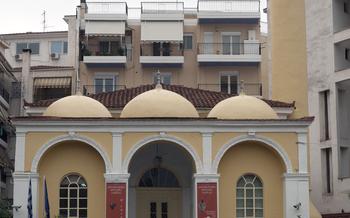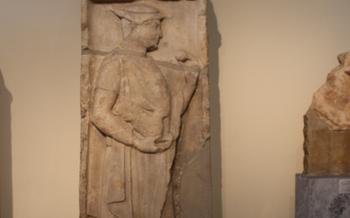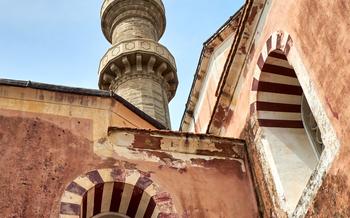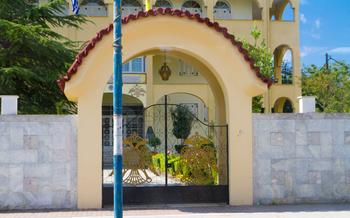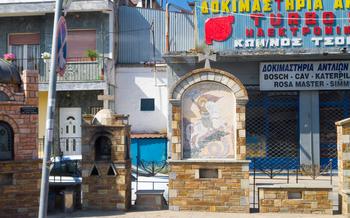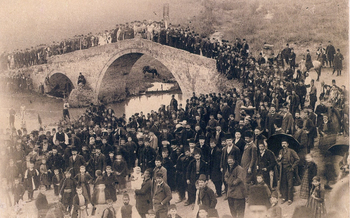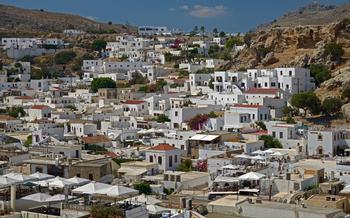
Frourio Hill
- Frourio Hill: A Majestic Panorama of Larissa
- The Acropolis of Larissa: A City's Ancient Heart
- The Castle of Larissa: A Medieval Masterpiece
- The Archaeological Museum of Larissa: A Treasure Trove of History
- The Church of Agios Achillios: A Byzantine Legacy
- The Yeni Mosque: A Symbol of Ottoman Rule
- The Old Town of Larissa: A Labyrinth of Charm
- The Central Market of Larissa: A Culinary Adventure
- The Municipal Park of Larissa: An Oasis of Tranquility
- The River Pinios: A Natural Haven
- The Mills of Paparouna: A Glimpse into the Past
- The Battle of Farsala: A Historical Landmark
- The Village of Tyrnavos: A Culinary Paradise
- The Meteora Monasteries: A Spiritual Retreat
- Insider Tip: Unveiling Hidden Gems
Frourio Hill: A Majestic Panorama of Larissa
Frourio Hill, also known as Larissa Castle, stands as a majestic sentinel overlooking the city of Larissa and the sprawling Thessalian Plain. Its strategic location and historical significance make it a must-visit destination for anyone seeking to delve into the rich tapestry of Greece's past.
The hilltop, crowned by the remains of an ancient fortress, offers breathtaking vistas of the city below and the surrounding countryside. The panoramic views encompass the meandering Pinios River, the fertile agricultural lands, and the distant mountain ranges, creating a picturesque landscape that captivates the senses.
As visitors explore the ruins of the ancient fortifications, they embark on a journey through time, uncovering the secrets of Larissa's storied past. The remnants of walls, towers, and gates whisper tales of battles fought and empires that rose and fell. The hilltop sanctuary, dedicated to the goddess Athena, evokes a sense of awe and reverence, inviting visitors to ponder the religious beliefs and practices of ancient Greece.
At sunset, Frourio Hill transforms into a magical realm. The sky bursts into a kaleidoscope of colors, painting the horizon with hues of gold, crimson, and purple. As night descends, the city lights twinkle like a constellation of stars, creating a mesmerizing spectacle that rivals the brilliance of the Milky Way above.
The Acropolis of Larissa: A City's Ancient Heart
The Acropolis of Larissa, a captivating hilltop citadel, stands as a testament to the city's rich and storied past. Archaeological excavations have unveiled the ruins of ancient temples, theaters, and public buildings, offering a glimpse into the grandeur of Larissa's classical heritage.
One of the most significant structures is the Ancient Theater, dating back to the 3rd century BC. With a seating capacity of over 5,000 spectators, this well-preserved theater hosted dramatic performances, musical concerts, and civic assemblies. The Odeon, a smaller theater dedicated to musical performances, is another notable highlight.
Among the religious structures, the Temple of Apollo Pythios holds a prominent place. Dedicated to the Greek god Apollo, this temple once housed a colossal statue of the deity. The Sanctuary of Cybele, a Phrygian goddess, is another significant religious site, featuring intricate carvings and inscriptions that provide insights into ancient rituals and beliefs.
Exploring the Acropolis is a journey through time, where visitors can touch the stones that witnessed the rise and fall of civilizations. From the foundations of ancient temples to the remnants of public buildings, the Acropolis stands as a symbol of Larissa's enduring legacy, inviting visitors to delve into the depths of its storied past.
The Castle of Larissa: A Medieval Masterpiece
The Castle of Larissa stands as a testament to the city's rich and tumultuous history, embodying the architectural influences of various civilizations that have shaped its identity. Originally constructed by the Byzantines in the 6th century AD, the castle served as a defensive fortress against invading forces. It was later expanded and fortified by the Ottomans during their occupation of the region, blending Byzantine and Islamic architectural elements into a unique masterpiece.
Exploring the castle's grounds reveals a fascinating journey through time. Visitors can wander through its imposing towers, each with its own distinct character and strategic purpose. The massive walls, adorned with intricate stonework, showcase the engineering prowess of its builders and provide a glimpse into the defensive strategies of the past. The castle's gates, once heavily guarded, now offer passage to a world of history and intrigue.
Delving deeper into the castle's secrets, visitors can uncover the hidden chambers and tunnels that lie beneath its surface. These subterranean passages, once used for storage, shelter, or escape routes, now offer a glimpse into the castle's hidden past. The castle's transformation into a venue for cultural events and exhibitions adds a contemporary touch to its ancient charm, making it a vibrant hub of art and history.
The Archaeological Museum of Larissa: A Treasure Trove of History
The Archaeological Museum of Larissa stands as a testament to the city's rich and diverse past, housing a remarkable collection of artifacts that span from prehistoric times to the Roman era. As you enter the museum, you are greeted by a captivating array of sculptures, pottery, and jewelry, each piece telling a unique story of Larissa's ancient heritage.
Among the highlights of the collection is a stunning marble statue of Apollo, the Greek god of music and prophecy. The statue, dating back to the 5th century BC, showcases the exceptional craftsmanship and artistry of ancient Greek sculptors. Another notable exhibit is a collection of intricately painted pottery from the Neolithic period, providing a glimpse into the daily lives and customs of Larissa's earliest inhabitants.
To enhance your museum experience, interactive exhibits and educational programs are offered, making history come alive for visitors of all ages. The museum also serves as a valuable resource for researchers and scholars, providing access to a wealth of information and artifacts for further study and exploration.
The Church of Agios Achillios: A Byzantine Legacy
The Church of Agios Achillios stands as a testament to Larissa's rich Byzantine heritage. Dedicated to the city's patron saint, Saint Achillios, the church holds a significant place in the religious and cultural fabric of the city.
Constructed in the 10th century, the church's architecture displays a harmonious blend of Byzantine and Classical elements. Its impressive dome, supported by four massive columns, dominates the interior, creating a sense of grandeur and reverence. The church's interior is adorned with exquisite frescoes, depicting scenes from the life of Saint Achillios and other religious figures.
Beyond its architectural and artistic significance, Agios Achillios Church is a living place of worship. Every year, on November 15th, the city celebrates the feast day of Saint Achillios with a grand festival. Pilgrims and visitors flock to the church to pay homage to the saint and seek his blessings.
The church is not only a religious site but also a cultural landmark. It has survived centuries of history, witnessing the rise and fall of empires and the evolution of Larissa's urban landscape. Today, it stands as a symbol of the city's enduring faith and its deep connection to its Byzantine roots.
The Yeni Mosque: A Symbol of Ottoman Rule
The Yeni Mosque, also known as the New Mosque, stands as a tangible reminder of Larissa's Ottoman past. Built in the 16th century during the reign of Suleiman the Magnificent, the mosque is a testament to the city's rich cultural heritage. Its architectural features, including the elegant dome and slender minaret, showcase the blending of Islamic and Byzantine influences. The intricate decorative elements, such as the colorful tilework and calligraphy, add to the mosque's aesthetic appeal.
Beyond its architectural significance, the Yeni Mosque holds historical importance as a symbol of religious tolerance in Larissa. During the Ottoman period, the city was home to a diverse population of Muslims, Christians, and Jews. The Yeni Mosque served as a place of worship for the Muslim community and coexisted peacefully with other religious institutions. Today, the mosque continues to be a symbol of interfaith dialogue and understanding.
Presently, the Yeni Mosque is not only a religious site but also a popular tourist attraction. Its stunning architecture and historical significance draw visitors from around the world. The mosque is open to the public during specific hours, allowing non-Muslims to appreciate its beauty and learn about its cultural importance. Guided tours are available to provide insights into the mosque's history, architecture, and religious significance.
Visiting the Yeni Mosque offers a unique opportunity to delve into Larissa's multicultural past and gain a deeper understanding of the city's diverse heritage. It is a must-see destination for anyone interested in history, architecture, and interfaith dialogue.
The Old Town of Larissa: A Labyrinth of Charm
The old town of Larissa is a captivating maze of narrow cobblestone streets, traditional houses with overhanging balconies, and hidden courtyards. This historic district has remained largely unchanged for centuries, offering a glimpse into the city's rich past.
Exploring the old town is like stepping back in time. The whitewashed houses with their colorful shutters and intricate wrought-iron balconies create a picturesque setting. Bougainvillea and jasmine vines cascade over the walls, adding a touch of fragrance to the air.
Within the old town's labyrinthine streets, visitors can discover a treasure trove of local shops, cafes, and tavernas. Traditional Greek handicrafts, such as ceramics, woven goods, and jewelry, are displayed in abundance. The cafes offer a respite from the bustling streets, where visitors can relax and savor a cup of Greek coffee or a refreshing lemonade.
In the heart of the old town lies the central square, known as Plateia Tahtara. This lively square is surrounded by cafes, restaurants, and shops. It's a popular gathering spot for locals and tourists alike, who come here to socialize, enjoy a meal, or simply watch the world go by.
The old town is also home to several historic churches and mosques, including the Church of Agios Nikolaos and the Yeni Mosque. These architectural landmarks offer a glimpse into the city's diverse religious heritage.
With its charming atmosphere, vibrant energy, and rich history, the old town of Larissa is a must-visit for anyone exploring the city. It's a place where visitors can wander aimlessly, soak up the local culture, and discover hidden gems around every corner.
The Central Market of Larissa: A Culinary Adventure
The Central Market of Larissa is a vibrant and bustling marketplace that offers a tantalizing glimpse into the city's culinary culture. Located in the heart of the city, the market has been a hub of activity since the Ottoman period, serving as a meeting point for locals to buy, sell, and trade goods.
As you approach the market, the air is filled with a symphony of sounds and scents. Vendors call out their wares, the clatter of pots and pans echoes through the narrow aisles, and the aroma of freshly baked bread and grilled meats wafts through the air. The market is a feast for the senses, with colorful stalls displaying an array of fresh produce, spices, herbs, cheeses, olives, and traditional Greek delicacies.
One of the highlights of the market is the opportunity to sample traditional Greek cuisine and street food. From souvlaki and gyros to spanakopita and loukoumades, there is something to satisfy every palate. Visitors can savor the flavors of Greece while enjoying the lively atmosphere of the market.
The Central Market is not just a place to buy and sell goods; it is also a place to interact with locals and experience the city's vibrant culture. The market is a melting pot of cultures, where people from all walks of life come together to share stories, laughter, and the love of food.
Whether you are a seasoned foodie or simply looking to experience the authentic flavors of Greece, the Central Market of Larissa is a must-visit destination. Immerse yourself in the sights, sounds, and smells of this vibrant marketplace, and let your taste buds guide you on a culinary adventure through the heart of Larissa.
The Municipal Park of Larissa: An Oasis of Tranquility
Amidst the vibrant streets of Larissa, a haven of tranquility awaits in the form of the Municipal Park. Established in the early 20th century, this sprawling green space offers a respite from the city's hustle and bustle, inviting visitors to relax, rejuvenate, and reconnect with nature.
Strolling through the park's lush gardens, visitors are greeted by a symphony of colors and fragrances. Roses, lilies, and bougainvillea bloom in profusion, while the air is filled with the sweet scent of jasmine and honeysuckle. The park's many trees provide shade from the summer sun, creating a cool and inviting atmosphere.
Families with young children will delight in the park's playgrounds, which offer a variety of swings, slides, and climbing structures to keep little ones entertained for hours on end. There's also a designated area for picnics, where families can spread out a blanket and enjoy a leisurely meal surrounded by nature's beauty.
For those seeking a more active experience, the park offers a network of walking trails that wind through its serene landscapes. Whether you prefer a leisurely stroll or a brisk jog, the park's trails are the perfect place to get some exercise and fresh air.
At the heart of the park lies a picturesque lake, a popular spot for relaxation and contemplation. Visitors can take a leisurely boat ride on the lake, admire the water lilies that bloom on its surface, or simply sit by the shore and enjoy the tranquil atmosphere.
In the evenings, the park transforms into a magical wonderland, as the trees and pathways are illuminated by soft lighting. This creates a romantic and inviting ambiance, making the park a popular spot for couples to stroll hand-in-hand or enjoy a quiet picnic under the stars.
The Municipal Park of Larissa is a true oasis of tranquility, offering a welcome respite from the city's hustle and bustle. Whether you're looking to relax with a good book, enjoy a family picnic, or get some exercise, this beautiful park has something to offer everyone.
The River Pinios: A Natural Haven
The River Pinios, also known as the Peneus, is a significant geographical feature of Larissa, flowing through the heart of the city and contributing to its natural beauty. With its source in the Pindus Mountains, the river meanders through the Thessalian Plain before emptying into the Thermaic Gulf. Exploring the river's scenic banks offers a refreshing respite from the urban landscape and a chance to discover its rich biodiversity.
Strolling along the riverbank, visitors can admire the lush vegetation that lines the river's edge, providing a habitat for a variety of plant and animal species. The river's crystal-clear waters are home to a diverse array of fish, making it a popular spot for fishing enthusiasts. Kayaking and canoeing are also popular activities, allowing visitors to explore the river's tranquil waters and admire the surrounding scenery from a unique perspective.
The river's ecological significance extends beyond its aquatic life. Its fertile banks have been used for agricultural purposes for centuries, supporting the cultivation of crops and providing sustenance to the local population. The river also plays a crucial role in the region's water supply, providing irrigation for farms and drinking water for the city of Larissa.
Overall, the River Pinios stands as a natural haven within the urban fabric of Larissa, offering a serene escape and a chance to connect with the region's rich biodiversity. Whether it's for fishing, kayaking, or simply enjoying a leisurely stroll along its banks, the river provides a refreshing and rejuvenating experience for visitors and locals alike.
The Mills of Paparouna: A Glimpse into the Past
Nestled in the picturesque village of Paparouna, just outside Larissa, lies a fascinating testament to the region's rich industrial heritage: the Mills of Paparouna. These beautifully restored mills, dating back to the 18th century, offer a unique glimpse into the traditional milling techniques and practices of yesteryear.
Exploring the mills is like stepping back in time. Each mill is a testament to the ingenuity and craftsmanship of the era, with its intricate machinery and grinding stones still intact. Visitors can learn about the different types of grains that were milled here, as well as the various processes involved in producing flour and other products.
In addition to the mills themselves, the site also features a museum dedicated to the history and cultural significance of milling in the region. Here, visitors can discover a collection of artifacts, tools, and documents that provide a deeper understanding of the role that these mills played in the local economy and way of life.
The Mills of Paparouna are not just a historical attraction; they are also a symbol of the region's ongoing commitment to preserving its cultural heritage. Today, the mills serve as a venue for cultural events, workshops, and demonstrations, ensuring that the traditional skills and knowledge associated with milling continue to be passed down to future generations.
The Battle of Farsala: A Historical Landmark
The Battle of Farsala, fought in 48 BC on the plains of Farsala, 25 kilometers northeast of Larissa, stands as a pivotal moment in ancient Greek history. This epic clash between the forces of Julius Caesar and Pompey the Great determined the fate of the Roman Republic and ushered in an era of imperial rule.
History and Significance:
The Battle of Farsala was the culmination of a series of political and military conflicts between Caesar and Pompey, two of the most powerful figures in the Roman Republic. Caesar's victory cemented his dominance over Rome, leading to the establishment of the Roman Empire and the end of the Republic.
Exploring the Battlefield:
Visitors to Larissa can explore the battlefield of Farsala, which is marked by a monument commemorating the battle. The surrounding landscape, with its rolling hills and fertile plains, provides a glimpse into the setting of this historic event.
Strategies and Tactics:
The Battle of Farsala was a clash of military tactics and strategies. Caesar's forces, outnumbered but more disciplined, employed innovative battle formations and cavalry maneuvers to overcome Pompey's larger army.
Turning Point in History:
The outcome of the Battle of Farsala had a profound impact on the course of Roman history. Caesar's victory paved the way for the establishment of the Roman Empire, marking a transition from a republic to an imperial system of government.
A Legacy of Conflict:
The Battle of Farsala serves as a reminder of the pivotal role that Larissa and the surrounding region have played in shaping the course of history. This ancient conflict continues to captivate historians and enthusiasts alike, offering insights into the power struggles and political machinations that shaped the ancient world.
The Village of Tyrnavos: A Culinary Paradise
Nestled amidst the picturesque Thessalian countryside, just a short drive from Larissa, lies the charming village of Tyrnavos. Renowned for its rich culinary traditions and delectable local delicacies, Tyrnavos is a haven for food lovers and culinary enthusiasts.
The village's history is deeply intertwined with its culinary heritage. Once a prosperous trading center, Tyrnavos attracted merchants and travelers from across the region, who brought with them their own culinary influences. Over the centuries, these influences blended and evolved, resulting in the unique and diverse cuisine that Tyrnavos is famous for today.
Exploring the village's narrow cobblestone streets, visitors are greeted by the tantalizing aromas wafting from traditional tavernas and bakeries. Local specialties include succulent sausages, flavorful cheeses, and mouthwatering pastries, all made using fresh, locally sourced ingredients and traditional recipes passed down through generations.
For those seeking a truly immersive culinary experience, Tyrnavos hosts several food festivals and events throughout the year. These events celebrate the village's rich gastronomic heritage and provide visitors with the opportunity to sample a wide variety of local delicacies, meet the passionate food artisans who create them, and learn about the stories behind each dish.
Whether you're a seasoned foodie or simply looking to indulge in some of Greece's finest culinary delights, a visit to Tyrnavos is an absolute must. With its charming atmosphere, friendly locals, and abundance of culinary treasures, this picturesque village is sure to leave a lasting impression on your taste buds and memories.
The Meteora Monasteries: A Spiritual Retreat
A Sanctuary in the Sky
Nestled atop towering rock formations in the Thessalian region, the Meteora Monasteries stand as a testament to the spiritual devotion and architectural ingenuity of bygone eras. These awe-inspiring structures, perched precariously on sheer cliffs, have captivated the imaginations of pilgrims and travelers alike for centuries.
A Journey Through Time
The history of the Meteora Monasteries dates back to the 11th century, when hermits seeking solitude and communion with the divine first made their homes in the region's caves. Gradually, as more and more hermits arrived, they began to construct small churches and monasteries, using ropes and pulleys to transport building materials up the steep cliffs.
Architectural Marvels
Today, six of these monasteries remain, each a unique masterpiece of architecture and engineering. The most famous among them is the Monastery of Great Meteoron, founded in the 14th century and home to a collection of priceless Byzantine icons and manuscripts. The Monastery of Varlaam, with its intricate frescoes and stunning views, is another must-see.
A Realm of Serenity and Beauty
Visiting the Meteora Monasteries is an experience that transcends the ordinary. As you wind your way through the narrow paths and ascend the steep steps, you'll be rewarded with breathtaking views of the surrounding landscape. The monasteries themselves exude an aura of peace and tranquility, inviting you to slow down, reflect, and connect with your spiritual side.
A UNESCO World Heritage Site
In recognition of their outstanding cultural and historical significance, the Meteora Monasteries were designated a UNESCO World Heritage Site in 198Today, they welcome visitors from around the globe, who come to marvel at their architectural beauty, immerse themselves in their spiritual atmosphere, and experience the serenity of this truly unique destination.
Insider Tip: Unveiling Hidden Gems
Beyond the well-known attractions, Larissa offers a treasure trove of hidden gems waiting to be explored. Immerse yourself in the city's rich history and culture by visiting the Museum of History and Art, which houses a fascinating collection of artifacts and artworks from Larissa's past. Discover the Municipal Gallery, showcasing contemporary art exhibitions by local and international artists. Delve into the Jewish Quarter, with its unique synagogue and poignant stories of the city's Jewish community.
Unleash your taste buds by venturing off the beaten path and sampling the culinary delights of Larissa. Participate in a traditional Greek cooking class, learning the secrets of mouthwatering dishes like moussaka, pastitsio, and spanakopita. Join a food tour, savoring the flavors of local specialties such as koulouri, tyropita, and bougatsa. Engage with the friendly locals, eager to share their customs and traditions. Immerse yourself in the vibrant atmosphere of a traditional Greek kafeneion, sipping on a cup of aromatic Greek coffee and engaging in lively conversations with the locals.
From exploring hidden museums and galleries to indulging in culinary adventures and connecting with the local community, Larissa offers an array of experiences beyond the usual tourist trail. Embrace the opportunity to uncover these hidden gems and create lasting memories in this captivating city.
